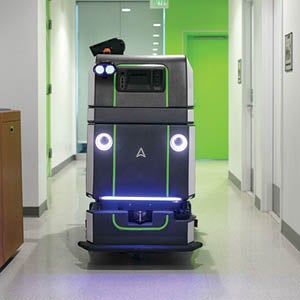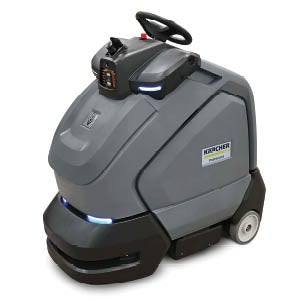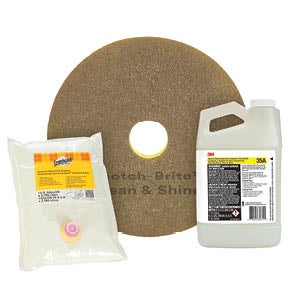New solutions overcome health care floor cleaning challenges

Image courtesy of Kaivac
Improved productivity, ergonomics, maneuverability and ease of use have all become deciding factors for health care facilities specifying floor cleaning and maintenance equipment.
Other trends include the evolution of smaller machines capable of performing multiple cleaning tasks as well as robotics, safety enhancements and artificial intelligence.
Also, manufacturers that supply the nation’s hospitals are seeing a continued emphasis on preventing health care-associated infections. This trend has been impacted by COVID-19 cleaning protocols developed over the past two years, with a transition from an initial high demand for disinfecting misters focused on surface disinfection to more recent investments in deep cleaning equipment.
There also is more demand for extractors, scrubbers, floor machines, air purifiers, vacuum cleaners with high-efficiency particulate air (HEPA) filtration and steamers.
“We are seeing higher demand for products that are battery driven — eliminating cord trip hazards and making it easier to clean hard-to-reach areas,” says Eric Henderson, product management manager, Tacony Corp., Fenton, Mo. “We also are seeing more demand for machines that are quieter and can be operated anytime, anywhere and with minimal distraction.”
Additionally, many machines now offer green technology, such as water recycling, low-moisture, environmentally friendly chemicals and even chemical-free options.
Something new
Floor care equipment recently introduced to the health care market incorporates many of these features. Whether a hospital is looking for vacuums, floor machines, sweepers or scrubbers, Tennant Co., Minneapolis, offers a variety of cleaning solutions under its Tennant, Nobles and IPC brands.
For example, Tennant has introduced the T380AMR robotic floor scrubber, a maneuverable, autonomous machine that provides a consistent, high standard of clean, according to Todd McClelland, senior strategic account manager for health care at Tennant. The robotic scrubber works alongside the cleaning team and allows the operator to press “run” and then focus on other tasks.
“Our line of robotic scrubbers is powered by BrainOs from our partners at Brain Corp., San Diego,” McClelland says. “This innovative software provides real-time data to environmental services (EVS) leaders — letting them know where, when and how an area was cleaned.”
Tennant also offers the i-mop XL and XXL Plus walk-behind scrubbers, which feature an upright design that offers maneuverability and operational benefits. “i-mop’s productivity is eight to 10 times higher than conventional mopping and cleans anywhere in a facility,” McClelland says. “Cleaning with a mop and bucket simply spreads around dirty water, in contrast to machines such as i-mop that have separate clean and recovery water tanks, which provides a cleaner clean.”
Tennant’s walk-behind, ride-on and robotic scrubbers, such as the T300, T350, T500 and T380AMR, feature ec-H20 NanoClean technology, which provides a chemical-free cleaning. “These walk-behind and stand-on scrubbers are great for everyday cleaning in large areas such as hallways and cafeterias,” McClelland says. “Many of our machines offer a quiet mode, ensuring the machine operates at low decibels, so they don’t disturb patients, visitors or staff.”
Tacony Corp. has three commercial floor care brands that offer a wide range of products to meet the needs of health care facilities: Tornado, Powr-Flite and Truvox International.
“Over the past 24 months, we have introduced multiple products in key categories that address current health care cleaning needs,” Henderson says. “This includes our line of Tornado CVD upright vacuums that feature true sealed HEPA filtration to reduce the expelling of contaminants into the air and maximize the removal of deeply embedded dirt in soft surface flooring.”
In addition, Tornado and Powr-Flite have launched a line of newly designed Surge and Pulsar extractors that maximize ease of use and deep cleaning results. Complementing these extractors, Tacony Corp. offers a line of Tornado CFR extractors that provide continuous fluid recycling that reduces water usage, extends productivity and offers ozone options on select models, providing odor control and sanitization.
For multi-surface cleaning, Tacony Corp. has introduced a line of compact multiwash, low-moisture, cylindrical scrubbers that deep clean with minimal use of water and solution. For hard surface cleaning, the company launched a line of Tornado walk-behind and stand-on scrubbers that are designed to reduce water usage, while offering easy operation and maintenance, Henderson says.
Intelligent solutions
Diversey, Fort Mill, S.C., offers TASKI and Twister product brands. TASKI auto scrubbers feature ergonomic design, low sound levels, open tank design and intelligent solutions that bring a wide range of benefits to health care facilities, according to Ryan Greenawald, director of marketing for facilities and machines in North America. “For example, TASKI Intelliflow helps to reduce water and cleaning solution consumption by 67%. The biggest advantage is that floor techs can run longer and reduce dump and refill cycles, thus saving time.”
Twister’s next generation of Intellipads are designed to clean a wide range of floors, last five times longer than standard pads and reduce the need for burnishing on traditional finished floors, according to Greenawald.
Twister pads come in a wide variety to maintain any floor type and have excelled on stone (e.g., terrazzo and polished concrete) without the need for finish, thus reducing maintenance costs. The Twister Extreme floor pad is designed as an alternative to chemical stripping by mechanically removing old finishes, thus providing a surface that can be recoated without the need for stripping and closing off areas for long periods of time.
“Twister pads are more effective than cleaning with conventional cleaning pads,” Greenawald says. “Each pad carries a different size of diamonds and cleans and smoothens the surface over time to bring the shine. Think of it as sanding wood to create a smooth surface and glossy look without destroying the properties and integrity of the floor, and reducing natural damage caused by scratches.”
Kaivac Inc., Hamilton, Ohio, offers the AutoVac Stretch, which provides an innovative approach to cleaning wide-area hard floor surfaces, according to Mike Perazzo, vice president of business development. AutoVac Stretch features a 10-gallon trolley bucket and 10-gallon vacuum tank.
The drop-down squeegee head and vacuum remove 99% of targeted soils, which means better infection prevention capabilities than mopping. The machine is touted as being maneuverable and easy to operate.
“In addition, the machine’s lithium-ion battery and recycling capability allow it to clean up to 25,000 square feet on one fill,” Perazzo says. “It’s also gentler on a floor’s finish than auto scrubbers while reducing damage to walls and fixtures from misuse.”
To improve safety, the AutoVac Stretch delivers one-pass cleaning, which leaves floors immediately dry, according to Perazzo. This means a reduced risk of slips and falls for staff, patients and visitors. It also means no downtime for critical areas while waiting for floors to dry. The machine has earned Green Seal certification, because it uses up to 75% less water and up to 66% fewer chemicals than other cleaning methods.
Robotic functions
Karcher North America, Aurora, Colo., has introduced the KIRA (Karcher Intelligent Robotic Application) B100 R, an automated scrubber with 29 gallons of cleaning capacity, according to Rex Shull, executive vice president for product development and engineering. The high-speed machine reportedly maneuvers easily, and features teach-and-repeat functionality.
“With new safety systems included in the software, these scrubbers can operate anywhere, at any time without endangering doctors, patients and visitors,” Shull says. “In addition, due to digital technology, facilities managers can see what spaces were cleaned and what spaces need to be revisited during any cleaning cycle.” The KIRA B 50, designed to clean smaller spaces, will be released sometime next year.
Avidbots Corp., Kitchener, Ontario, Canada, has developed the Neo autonomous floor scrubbing robot, which is designed to keep high-traffic facilities clean. Neo utilizes dynamic path planning and real-time obstacle avoidance, which makes it a good floor care solution for hospitals, according to Faizan Sheikh, CEO and co-founder. “With the ability to operate round-the-clock and adapt to its environment in real time, Neo can help increase the frequency of floor cleaning while enabling custodial teams to concentrate on other critical cleaning tasks.”
To ensure safe operation, Neo has 10 onboard sensors, which provide 360-degree visibility. This technology combines with safety features such as e-stop buttons, bumpers, beacons, integrated signaling lights, and a blue safety light and sound system. Avidbots Command Center, the company’s web-based software, enables EVS professionals to monitor, manage and track Neo — or an entire fleet of Neos — remotely and in real time.
Avidbots recently launched the Disinfection Add-On, which gives users the ability to autonomously disinfect high-touch surfaces. “With the Disinfection Add-On, users can disinfect surfaces for a few hundred dollars per month — combining two applications, such as floor care and high-touch surface disinfection, into one.”
Other tools
3M, Minneapolis, recently unveiled a floor care system designed to fit seamlessly into ongoing maintenance routines. Designed for resilient floors, the 3M Advanced Floor Care System is comprised of three Green Seal-certified products, including the Scotch-Brite Clean & Shine Daily Floor Enhancer, Scotch-Brite Clean & Shine Pads and Scotchgard Protect & Shine Floor Protector. The system reportedly allows hospitals to improve efficiency and achieve desired gloss level with less labor and fewer chemicals.
The Clean & Shine Pads combine cleaning and polishing tasks into one operation and may reduce or eliminate the need to burnish, according to Jim Erickson, application engineering technical manager for 3M Commercial Solutions Div. “The Protect & Shine Floor Protector reduces floor maintenance by requiring less chemical stripping and less frequent burnishing,” Erickson says. “The floor coating it creates also resists scratches and can protect against degradation caused by hand sanitizer.”
The Clean & Shine Daily Floor Enhancer allows facilities professionals to repair the micro-scratches that get into a floor from general traffic. By stretching out the time between a full scrub and recoat, a hospital can save on chemicals and labor while limiting interruptions to operations.
Ecolab Inc., St. Paul, Minn., has introduced the Ecolab mop, which combines microfiber technology with loops to increase cleaning effectiveness. The system has an ergonomic Z-style handle and mop holder. The Z-style handle helps to reduce stress on the user’s wrists, arms, shoulders and lower back. The system also is available with a straight handle design.
In addition, Ecolab offers the Phazer Mobile Floor Care System, an ergonomically designed floor finish applicator system that is available in hard-shell and soft-shell backpack versions.
Looking ahead
Autonomous floor cleaning equipment will become the standard method of cleaning in hospitals, Henderson predicts, due to a lack of a sustainable workforce along with the benefits of limiting exposure of people to pathogens.
“Multi-function robots designed to clean many surface types will become the norm, driven by artificial intelligence that will be able to monitor the status and cleanliness of facilities and clean when needed, not only on a set schedule,” Henderson adds.

RISE OF THE ROBOTS
The Neo autonomous floor scrubbing robot is designed to keep high-traffic facilities clean. Avidbots Corp.

BENEFICIAL OPTIONS
These auto scrubbers have ergonomic features, low sound levels, an open tank design and intelligent solutions that bring a wide range of benefits to hospitals. Diversey TASKI

EFFICIENCY UPGRADE
The AutoVac Stretch floor cleaner helps hospitals remove 99% of targeted soils from floors three to four times faster than mopping without the cross-contamination. Kaivac Inc.

CLEVER CLEANING
The Ecolab mop combines microfiber technology with loops to increase cleaning effectiveness. Ecolab Inc.

SMART SYSTEM
The KIRA CV 60/1 autonomous robotic vacuum is powered by an artificial intelligence-based operating system and navigates around people and obstacles. Karcher North America

COST CONSCIOUS
T300 walk-behind scrubbers feature ec-H20 NanoClean, which reduces chemical and water costs while cleaning. Tennant Co.

SYSTEM APPROACH
Designed for resilient floors, the 3M Advanced Floor Care System allows hospitals to achieve their desired gloss level with less labor and fewer chemicals. 3M

CLEAR THE AIR
Tornado CVD upright vacuums feature true sealed HEPA filtration to reduce the expelling of contaminants in the air and maximize the removal of deeply embedded dirt in soft surface flooring. Tacony Corp.
Neal Lorenzi is a Mundelein, Ill.-based contributor to Health Facilities Management.




